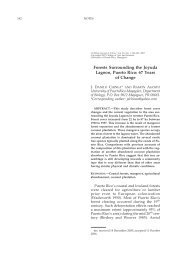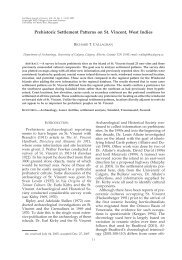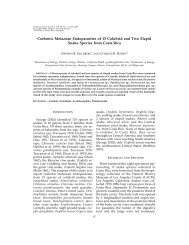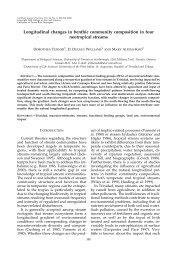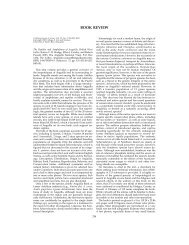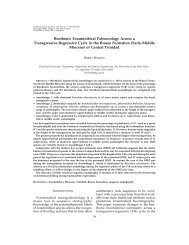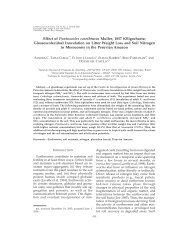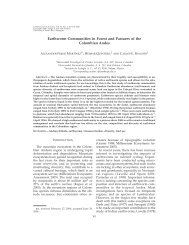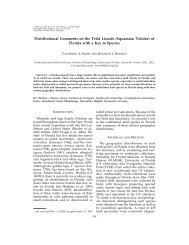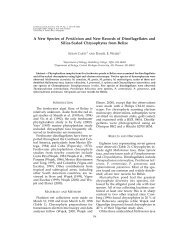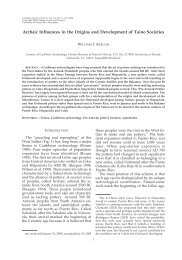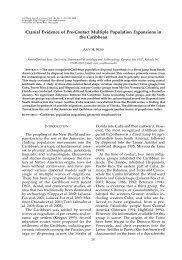Blood Parasites in Birds From the Lowlands of Northern Colombia
Blood Parasites in Birds From the Lowlands of Northern Colombia
Blood Parasites in Birds From the Lowlands of Northern Colombia
You also want an ePaper? Increase the reach of your titles
YUMPU automatically turns print PDFs into web optimized ePapers that Google loves.
92<br />
A. LODOÑO ET AL.<br />
modium (60% <strong>of</strong> all <strong>in</strong>fections) was <strong>the</strong> most<br />
common protozoa <strong>in</strong> domesticated birds,<br />
which makes <strong>the</strong> availability <strong>of</strong> vectors a<br />
poor explanation <strong>of</strong> <strong>the</strong> phenomena, at<br />
least it were species <strong>of</strong> mosquito resistant to<br />
that k<strong>in</strong>d <strong>of</strong> <strong>in</strong>secticide. We claim that biologic<br />
factors (immunology, ecology, behavior,<br />
to mention someth<strong>in</strong>g) <strong>of</strong> Neotropical<br />
birds more than sampl<strong>in</strong>g methods are account<strong>in</strong>g<br />
for <strong>the</strong> observed prevalence <strong>of</strong><br />
blood parasites <strong>in</strong> <strong>the</strong> Neotropics.<br />
Never<strong>the</strong>less, we cannot conclude unerr<strong>in</strong>gly<br />
that <strong>the</strong>re is a low frequency <strong>of</strong><br />
haematozoa <strong>in</strong> <strong>the</strong> lowlands <strong>of</strong> nor<strong>the</strong>rn<br />
<strong>Colombia</strong>. We have exam<strong>in</strong>ed different<br />
groups <strong>of</strong> birds with different life histories<br />
at different seasons and with few samples<br />
per bird species, which limits our possibilities<br />
to do comparisons, a disadvantage <strong>of</strong><br />
our sampl<strong>in</strong>g method. Opportunistic sampl<strong>in</strong>g<br />
has advantages only <strong>in</strong> unexplored<br />
areas where <strong>in</strong>formation <strong>of</strong> both, biodiversity<br />
<strong>of</strong> birds and blood parasites is unknown<br />
and also leaves a wider possibility<br />
to f<strong>in</strong>d new hosts <strong>of</strong> parasites. Groupdirected<br />
studies, on <strong>the</strong> o<strong>the</strong>r hand, have<br />
more advantages to establish prevalence.<br />
For example <strong>the</strong> families Tyrannidae, Cot<strong>in</strong>gidae<br />
and Furnariidae (sensu Remsen et<br />
al. 2004) are almost never <strong>in</strong>fected <strong>in</strong> o<strong>the</strong>r<br />
studies (like Bennett et al. 1991, Young et al.<br />
1993), but had more <strong>in</strong>fected species <strong>in</strong> our<br />
work than <strong>in</strong> <strong>the</strong>irs (Table 1), and moreover<br />
<strong>the</strong>se families had an <strong>in</strong>creased frequency<br />
<strong>of</strong> parasites <strong>in</strong> family focused studies as<br />
Matta et al. (2004). We suggest that without<br />
statistically designed studies with broad<br />
host samples from different seasons and at<br />
<strong>the</strong> same localities, it is difficult to draw<br />
conclusions regard<strong>in</strong>g <strong>the</strong> level <strong>of</strong> prevalence<br />
as such. It is better to carry out detailed<br />
exam<strong>in</strong>ations <strong>of</strong> specific groups <strong>of</strong><br />
birds (Tella et al. 1999, Matta et al. 2004).<br />
New analyses and additional data, <strong>in</strong>clud<strong>in</strong>g<br />
biology <strong>of</strong> both vertebrate and <strong>in</strong>vertebrate<br />
host, life cycles, physiology and genetic<br />
backgrounds are needed to resolve<br />
many questions about bird-parasite <strong>in</strong>teractions.<br />
Although <strong>the</strong> parasites have not been<br />
identified at <strong>the</strong> level <strong>of</strong> species, this short<br />
exploration is <strong>the</strong> first from this part <strong>of</strong> <strong>Colombia</strong>,<br />
and adds to our knowledge for<br />
<strong>the</strong> bird-parasite relationships <strong>in</strong> South<br />
America. Explorations with more ref<strong>in</strong>ed<br />
methods are required, because <strong>in</strong> 52 years<br />
only eight studies (<strong>in</strong>clud<strong>in</strong>g ours), and<br />
about 440 total species (c. 22% <strong>of</strong> <strong>the</strong> <strong>Colombia</strong>n<br />
avifauna) <strong>of</strong> birds have been exam<strong>in</strong>ed.<br />
Additional methods for haematozoa<br />
identification are also necessary to<br />
understand <strong>the</strong> ecological and evolutionary<br />
relationships between hosts, parasites and<br />
vectors occurr<strong>in</strong>g <strong>in</strong> <strong>the</strong> Neotropics.<br />
Acknowledgments.—We are <strong>in</strong>debted to<br />
Corantioquia and Corpourabá (entities that<br />
regulate <strong>the</strong> use <strong>of</strong> regional natural resources)<br />
for permission to catch birds <strong>in</strong><br />
<strong>the</strong>ir ecological jurisdiction, and to Servicio<br />
de Erradicación de Malaria <strong>in</strong> Turbo and<br />
Zaragoza for <strong>in</strong>troduc<strong>in</strong>g us to <strong>the</strong> forests.<br />
We thank Gabriel J. Colorado, Juan F. Díaz<br />
and Ana M. Castaño for <strong>the</strong>ir collaboration<br />
dur<strong>in</strong>g field work. Lastly to Sylvia M. Fallon<br />
and John T. Klicka for review<strong>in</strong>g <strong>the</strong><br />
manuscript, and Luciane Willcox for provid<strong>in</strong>g<br />
<strong>in</strong>formation about Brazilian blood<br />
parasite studies.<br />
LITERATURE CITED<br />
Ayala S. C., J. M. Rammakka, V. F. Rammakka, and<br />
C. E. Varela. 1977. Haemoproteus, Plasmodium, and<br />
Hippoboscid ectoparasites <strong>of</strong> <strong>Colombia</strong> wild<br />
doves. Rev. Inst. Med. Trop. Sao Paulo 19:411-416.<br />
Ayala, S. C., and C. E. Varela. 1975. Malaria en Chordeiles<br />
m<strong>in</strong>or (Aves: Caprimulgidae), an <strong>in</strong>tercont<strong>in</strong>ental<br />
migrant. Rev. Inst. Med. Trop. Sao Paulo 17:253-<br />
256.<br />
Bennett, G. F., and J. I. Borrero. 1976. <strong>Blood</strong> parasites<br />
<strong>of</strong> some birds from <strong>Colombia</strong>. J. Wildl. Dis. 12:454-<br />
458.<br />
Bennett, G. F., M. Garv<strong>in</strong>, and J. Bates 1991. Avian<br />
haematozoa from west-central Bolivia. J. Parasitol.<br />
77:207-211.<br />
Bennett, G. P., M. A. Peirce, and R. W. Ashford. 1993.<br />
Avian haematozoa: Mortality and pathogenicity.<br />
J. Nat. Hist. 27:329-334.<br />
Bishop, M. A., and G. F. Bennett. 1992. Host-parasite<br />
catalogue <strong>of</strong> <strong>the</strong> avian haematozoa, Supplement 1<br />
and Bibliography <strong>of</strong> <strong>the</strong> avian blood-<strong>in</strong>habit<strong>in</strong>g<br />
haematozoa, Supplement 2. Meml. Univ. Nfld.<br />
Ocass. Pap. Biol. 15:1-244.<br />
Cooper, J. E. 1989. Diseases and threatened birds. The<br />
significance <strong>of</strong> avian haematozoa <strong>in</strong> conservation<br />
strategies. ICPB, London, UK.<br />
Deviche, P., E. C. Gre<strong>in</strong>er, and X. Manteca. 2001. Seasonal<br />
and age-related changes <strong>in</strong> blood parasite



